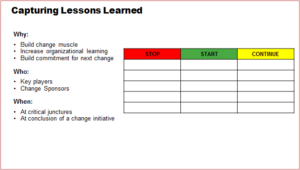Capture Lessons Learned For Transformation Success

Leadership
May 13, 2021
Marjorie Derven
Change leader focused on practical, sustainable progress to achieve strategic aspiration
Topics
Change, Change Management, Leadership, leadership lessons, organizational change, Project Management, transformationSuccessful transformations are inextricably linked to organizational and individual learning. Change today typically involves defining new roles, new ways of working, and automation adoption. Learning is the key accelerator to execute and sustain the desired future state.
Organizational capability to develop and continually strengthen a change management muscle is required for success in a world characterized by uncertainty. To be able to anticipate, adapt and sustain transformational change is promoted through the capture of lessons learned.
Taking the time to capture lessons learned from transformational change is rarely done as organizations are coping with multiple, concurrent change. The pace and complexity make it seem that taking time to look back and reflect on what works is a “nice to have” that is unnecessary. However, capturing lessons learned is essential to build organizational knowledge and resiliency.
The process for capturing lessons learned should be data-driven, involve a cross-section of multiple stakeholders, and incorporate critical factors, including a mix of business and people factors. A simple but effective model is the “Stop / Start / Continue approach shown here:
To be effective, the capture of lessons learned must be based on an organizational listening strategy which is visible, has credibility, and builds a track record of action planning.
Given the complexity and pace of change, selecting the right categories for data capture is essential to enable prioritization. Here are a few examples to consider for data capture, including change management and project management factors.
PROJECT MANAGEMENT
Achievement of business goals.
Were the intended objectives met and what were the factors that helped/hindered this?
Adherence to project plan.
Did the project plan prove to be an effective, flexible and agile road map for change and resource allocation?
Degree of business interruption.
To what degree were customer needs, internal business requirements, and operational functioning unnecessarily delayed or harmed?
Enhancement of operational excellence.
Did the transformation result in expected improvements in business functioning?
CHANGE MANAGEMENT
Organizational readiness.
Was an assessment initiated early on to establish baseline data about strengths and vulnerabilities, with data used to craft a change management plan?
Preparation of leaders and individuals.
Were affected employees at all levels properly informed with resources, training and effective rewards to make required shifts to pivot as needed to new requirements?
Cascade of effective communication.
Was the rationale and vision for the need for change clearly communicated to all affected stakeholders, deploying the right messaging at the right time through the best channels?
Measuring and tracking successes.
Was there an effective process, including baseline and pulse surveys, deployed to be able to define change management progress and take appropriate actions?
Adoption of change requires taking risks on both an organizational and personal level, letting go of old habits and mindsets. As Heraclites understood in 535 B.C., “You could not step twice into the same rivers; for other waters are ever flowing on to you,” no two transformation initiatives will be exactly alike, but learning lessons from each successive change effort will build a stronger transformation capability.







